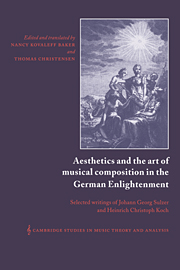 Aesthetics and the Art of Musical Composition in the German Enlightenment
Aesthetics and the Art of Musical Composition in the German Enlightenment Published online by Cambridge University Press: 30 September 2009
Heinrich Christoph Koch's central aim in writing his Versuch einer Anleitung zur Composition was to provide comprehensive instruction in composition. In this three-volume work, Koch formulates many rules and guidelines based upon his study of the current repertory to aid the beginning composer. He was aware, however, that theory alone could not account for all characteristics of music and therefore could not provide a complete foundation for compositional pedagogy. He thus sought to relate theory to aesthetics in order to explain the more intangible aspects of the art of composition. What in fact is the general purpose of a fine art such as music and how does this purpose help shape a given work? How would such a composition arise in the mind of a composer? Koch's answers to these and other questions in the following translation outline a process of composition which is guided by aesthetic considerations. His primary source was the extensive writings of Johann Sulzer, discussed and translated in this volume. Sulzer's theory of the fine arts was elaborate, but abstract with regard to particular arts, especially music. Koch, however, applied Sulzer's aesthetic ideas specifically to music and provided concrete illustrations. Irrespective of the question whether these ideas offer a practicable approach to learning composition, this portion of Koch's treatise is unique in the field of music theory and a significant contribution to the growing body of works concerning the process of composition in the latter part of the eighteenth century.
To save this book to your Kindle, first ensure no-reply@cambridge.org is added to your Approved Personal Document E-mail List under your Personal Document Settings on the Manage Your Content and Devices page of your Amazon account. Then enter the ‘name’ part of your Kindle email address below. Find out more about saving to your Kindle.
Note you can select to save to either the @free.kindle.com or @kindle.com variations. ‘@free.kindle.com’ emails are free but can only be saved to your device when it is connected to wi-fi. ‘@kindle.com’ emails can be delivered even when you are not connected to wi-fi, but note that service fees apply.
Find out more about the Kindle Personal Document Service.
To save content items to your account, please confirm that you agree to abide by our usage policies. If this is the first time you use this feature, you will be asked to authorise Cambridge Core to connect with your account. Find out more about saving content to Dropbox.
To save content items to your account, please confirm that you agree to abide by our usage policies. If this is the first time you use this feature, you will be asked to authorise Cambridge Core to connect with your account. Find out more about saving content to Google Drive.